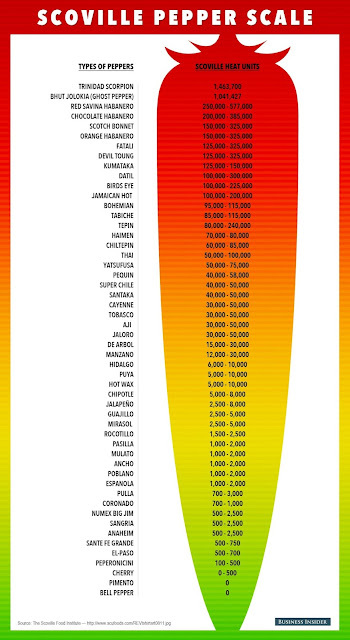PEPPER - part 2
Peppers come in a kaleidoscope of colours – from green, red
, yellow and orange to deep purple! They are generally good sources of vitamins A
and C, potassium, folic acid,
and fibre. Some are hot and spicy, others are sweet and tangy.
The Capsicum Bell pepper comes in green, orange, yellow, and
red. Red peppers tend to have the highest levels of nutrients because they've
been on the vine longest. Green peppers are harvested earlier, before they have
a chance to turn yellow, orange, and then red. Compared to green bell peppers,
the red ones have almost 11 times more beta-carotene (used for making Vitamin A)
and 1.5 times more vitamin C. Red peppers are an excellent source of vitamin C. A
red pepper is thought to have as much, if not more vitamin C than an orange. (180
mg per 100g in red bell pepper; compared with 53% in 100g)
One of the reasons that people eat pepper is for their flavor
and ‘hotness’ they bring to foods. I will be discussing the effects of eating peppers
on my next blog. But for now lets look at the reasons why some peppers are
hotter than others.
Hotness of Peppers: Capsaicin
is the substance that gives peppers their hotness. It is a colourless bitter compound.
All red peppers contain capsaicin, it is found principally in their flesh and
especially in their seeds and inner membranes.
The “hotness” of the various red peppers
is directly related to the amount of capsaicin in the fruit. A scale for
measuring the hotness of all peppers was developed by a gentleman called W.
Scoville in 1912. The Scoville scale is based on how diluted an extract of a pepper
can be made, and still be detected by the human palate.
Example: Habanero pepper has a rating of about 100,000
to 300,000 Scoville Heat Units (SHU); bell or sweet peppers, with little
or no capsaicin, are assigned a value of 0 or 1.
Besides causing our taste buds to
send nerve impulses to our brains to be interpreted as “hot”, capsaicin also
reddens the skin when applied externally. Harvesters of hot peppers
have been known to suffer with sight problems from forgetting to wash their
hands after handling hot peppers! It is important to wash your hands thoroughly
after handling hot peppers – and to refrain from making contact with eyes and face
and other sensitive areas.
What about Black and White pepper? Black
pepper comes from the berries of the pepper plant. Black pepper, green pepper
and white peppercorns are actually the same fruit (Piper nigrum); the
difference in their colour is a reflection of varying stages of development and
processing methods. Black peppercorns are made by picking the pepper berries
when they are half ripe and just about to turn red. They are then left to dry
which causes them to shrivel and become dark in color. Alternatively, green
peppercorns are picked while still unripe and green in color, while white
peppercorns are picked when very ripe and subsequently soaked in brine to
remove their dark outer shell leaving just the white pepper seed.
Red Peppers are unrelated to
black pepper and white pepper. Black pepper and white pepper come from a
vine native to India. black pepper is the unripened fruit (peppercorn)
that has been dried in the sun. White Pepper is the ripened fruit that
has been soaked and rubbed to remove the outer covering.
From the Coleville scale you will see that the Bell papers
are very low in ‘hotness’, and gradually we see the level of Capsaicin increases
as we proceed up the scale. A Jalepeno – common in Mexican dishes is 2,500 – 8,000
units, compared to the Jamaican hot – which is 100,000 to 200,000 units.
The scotch bonnet is commonly used in West Africa (known as Ata rodo in Nigeria) and West Indian dishes is quite high on the scale. The highest and most peppery pepper is 1,463, 700 units. This is the Trinidadian Scorpion; some charts show this as the Californian Reaper…either way it is HOT!
The scotch bonnet is commonly used in West Africa (known as Ata rodo in Nigeria) and West Indian dishes is quite high on the scale. The highest and most peppery pepper is 1,463, 700 units. This is the Trinidadian Scorpion; some charts show this as the Californian Reaper…either way it is HOT!
So how hot is your pepper?

No comments:
Post a Comment